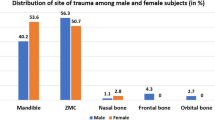Abstract
Aim
The etiology and epidemiology of maxillofacial injuries varies widely in different regions of the world due to socioeconomic status, cultural aspects in addition to road traffic and drug consumption. The aim of this study is to determine major causes and epidemiological characteristics of maxillofacial trauma in a 5-year period.
Materials and methods
Reports of corporal trauma (n = 25,632) from 2007 to 2011 in the Department of Forensic Medicine were analyzed as to the presence of maxillofacial injuries. Data were submitted to Chi square test and to multivariate Poisson regression.
Results
3262 reports referred maxillofacial trauma. The majority were men (55.8%), single (68.9%), most of them white (75.7%). The average age was 28.9 years (SD = 8.42), and victims with age between 16 and 30 years old were the most affected (48.0%). Women comprised 44% of total sample, 67.8% (971) were single, 76% (1.076) white and 46% (691) aged between 16 and 30 years old. Middle third injuries were associated after adjustment with females (PR 1.05; 95% CI 1.01–1.11), non-white subjects (PR 1.06; 95% CI 1.01–1.12) and physical aggression (PR 1.07; 95% CI 1.02–1.13). Injuries in the oral region was more prevalent in men (PR 1.24; 95% CI 1.09–1.41), in those aged between 16 and 30 (PR 1.97; 95% CI 1.48–2.61) and in subjects with injuries caused by traffic accident (PR 1.21; 95% CI 1.02–1.44). The presence of injuries in the lower third of face remained associated in the final model only with traffic accident (PR 1.75; 95% CI 1.43–2.15).
Conclusion
Health care practitioners must recognize vulnerable population and most prevalent sites of lesion to identify cases of violence.
Similar content being viewed by others
References
Soriano EP, Caldas AF Jr, Goes OS (2004) Risk factors related to traumatic dental injuries in Brazilian schoolchildren. Dent Traumatol 20(5):246–250
Brauer JC (1950) The treatment of children’s fractured permanent anterior teeth. J Am Dent Assoc 41(4):399–407
Muelleman RL, Lenaghan PA, Pakieser RA (1996) Battered women: injury locations and types. Ann Emerg Med 28(5):486–492
Ochs HA, Neuenschwander MC, Dodson TB (1996) Are head, neck and facial injuries markers of domestic violence? J Am Dent Assoc 127(6):757–761
Thoren H, Snall J, Salo J, Suominen-Taipale L, Kormi E, Lindqvist C et al (2010) Occurrence and types of associated injuries in patients with fractures of the facial bones. J Oral Maxillofac Surg 68(4):805–810
Singh V, Malkunje L, Mohammad S, Singh N, Dhasmana S, Das SK (2012) The maxillofacial injuries: a study. Natl J Maxillofac Surg 3(2):166–171
Lee KH, Snape L, Steenberg LJ, Worthington J (2007) Comparison between interpersonal violence and motor vehicle accidents in the aetiology of maxillofacial fractures. ANZ J Surg 77(8):695–698
Brasileiro BF, Passeri LA (2006) Epidemiological analysis of maxillofacial fractures in Brazil: a 5-year prospective study. Oral Surg Oral Med Oral Pathol Oral Radiol Endod 102(1):28–34
Lee KH (2009) Interpersonal violence and facial fractures. J Oral Maxillofac Surg 67(9):1878–1883
Centers for Disease C, Prevention (2008) Adverse health conditions and health risk behaviors associated with intimate partner violence–United States, 2005. MMWR Morb Mortal Wkly Rep 57(5):113–117
Garcia-Moreno C, Jansen HA, Ellsberg M, Heise L, Watts CH, Health WHOM-cSoWs et al (2006) Prevalence of intimate partner violence: findings from the WHO multi-country study on women’s health and domestic violence. Lancet 368(9543):1260–1269
Arosarena OA, Fritsch TA, Hsueh Y, Aynehchi B, Haug R (2009) Maxillofacial injuries and violence against women. Arch Fac Plast Surg 11(1):48–52
Campbell JC (2002) Health consequences of intimate partner violence. Lancet 359(9314):1331–1336
McCaw B, Golding JM, Farley M, Minkoff JR (2007) Domestic violence and abuse, health status, and social functioning. Women Health 45(2):1–23
Bonomi AE, Thompson RS, Anderson M, Reid RJ, Carrell D, Dimer JA et al (2006) Intimate partner violence and women’s physical, mental, and social functioning. Am J Prev Med 30(6):458–466
Rivara FP, Anderson ML, Fishman P, Bonomi AE, Reid RJ, Carrell D et al (2007) Healthcare utilization and costs for women with a history of intimate partner violence. Am J Prev Med 32(2):89–96
Le BT, Dierks EJ, Ueeck BA, Homer LD, Potter BF (2001) Maxillofacial injuries associated with domestic violence. J Oral Maxillofac Surg 59(11):1277–1283; discussion 83-4
Saddki N, Suhaimi AA, Daud R (2010) Maxillofacial injuries associated with intimate partner violence in women. BMC Public Health 10:268
Garbin CA, Guimaraes e Queiroz AP, Rovida TA, Garbin AJ (2012) Occurrence of traumatic dental injury in cases of domestic violence. Braz Dent J 23(1):72–76
ADA. 99H-1996 (1996) In: Transactions ADA, editor. American Dental Association Chicago, p 684
Mallikarjuna SK, Krishnappa P (2009) Prevalence of maxillofacial injuries by motorized two wheeler road traffic accidents in Bangalore city. Dent Traumatol 25(6):599–604
Ravindran V, Ravindran Nair KS (2011) Metaanalysis of maxillofacial trauma in the northern districts of kerala: one year prospective study. J Maxillofac Oral Surg 10(4):321–327
Banks PBA (2001) Etiology, surgical anatomy and classification. In: Banks PBA (ed) Fractures of the facial skeleton. Elsevier, Philadelphia
Author information
Authors and Affiliations
Corresponding author
Ethics declarations
Conflict of interest
L. D. Conceição, I. A. da Silveira, G. G. Nascimento, R. G. Lund, R. H. A. da Silva, F. R. M. Leite state that there are no conflicts of interest. No funding supported this study. All procedures followed were in accordance with the ethical standards of the responsible committee on human experimentation (institutional and national) and with the Helsinki Declaration of 1975 (in its most recently amended version).
Rights and permissions
About this article
Cite this article
Conceição, L.D., da Silveira, I.A., Nascimento, G.G. et al. Epidemiology and Risk Factors of Maxillofacial Injuries in Brazil, a 5-year Retrospective Study. J. Maxillofac. Oral Surg. 17, 169–174 (2018). https://doi.org/10.1007/s12663-016-0994-3
Received:
Accepted:
Published:
Issue Date:
DOI: https://doi.org/10.1007/s12663-016-0994-3




